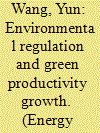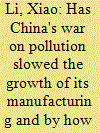| Srl | Item |
| 1 |
ID:
166537


|
|
|
|
|
| Summary/Abstract |
Global warming is one of the issues of great concern in the world. The large-scale use of fossil fuels has led to the continuous increase in carbon emissions, resulting in global energy shortages and environmental pollution. Reasonable and strict environmental regulation promotes technological innovation by enterprises to achieve a win-win situation between the economy and environment, which is the core idea of the Porter hypothesis. The choice of China, as the world's largest energy consumer and carbon emitter, is not only related to the country's own mode of economic growth but also determines the development of the world's low-carbon economy. We used the panel data from 2000 to 2016 of 30 provincial-level administrative regions in China and adopted the Propensity Score Matching–Difference in Differences method to test the impact of China's carbon trading pilot system on the transformation of a low-carbon economy. The empirical results show that under the constraints of the established resources and environment, there is a positive relationship to some extent between China's carbon trading system and low-carbon economic transformation. This relationship can realize the win-win situation of environmental and economic benefits as advocated by the Porter hypothesis and further verify the applicability of the Porter hypothesis.
|
|
|
|
|
|
|
|
|
|
|
|
|
|
|
|
| 2 |
ID:
169759


|
|
|
|
|
| Summary/Abstract |
In this paper, we test the weak and strong versions of the Porter hypothesis using data from 14 OECD countries over the period 1990–2011. Our analysis makes two contributions to the literature on the topic. First, we use a newly released environmental policy stringency index (EPS) provided by the OECD as an indicator for the stringency of environmental regulations, which addresses the multi-dimensionality of environmental regulations. Second, as a suitable method to deal with asymmetric distributions of the dependent variables, we use a panel-quantile regression model, which allow us to test whether or not the hypothesis holds for all quantiles of the distribution of the corresponding dependent variable. The findings indicate that in the short term a more strict environmental policy is associated with an increase in the number of patent applications and in total factor productivity (TFP) for the highest quantiles of the distribution of patents and for all quantiles of TFP, respectively. Moreover, environmental stringency has a positive effect on research and development expenditures (RD) only in the lower quantiles (10, 25). In the long term, the EPS is affecting RD, patents and TFP in all quantiles, and hence more stringent environmental regulations promote cleaner production processes that could help improving energy efficiency.
|
|
|
|
|
|
|
|
|
|
|
|
|
|
|
|
| 3 |
ID:
167001


|
|
|
|
|
| Summary/Abstract |
Green growth has become an important development strategy for OECD countries and governments have correspondingly implemented various environmental regulation policies, whereas few studies have discussed the impacts of environmental regulation on green productivity growth in OECD countries. Based on a panel data of OECD countries' industrial sectors, this study analyzes the stringency of environmental regulation policies and measures green productivity growth using an extended SBM-DDF approach. The dynamic panel regression investigates the impacts and mechanism of environmental policy stringency on green productivity growth in OECD countries’ industrial sectors. The main results are: (i) Porter hypothesis is validated that the environmental policy has a positive impact on green productivity growth within a certain level of stringency (lower than 3.08); (ii) The impact turns to be adverse when the environmental regulation policy is stringent over a certain level, as the compliance cost effect is higher than innovation offset effect. The findings provide new empirical evidence for the strong version of the Porter Hypothesis and some implications for OECD countries to further promote green growth.
|
|
|
|
|
|
|
|
|
|
|
|
|
|
|
|
| 4 |
ID:
163520


|
|
|
|
|
| Summary/Abstract |
We provide the first causal estimate of the aggregate effect of the 2013–2017 Clean Air Action, one of the largest and most recent environmental programs in China, on the growth of the manufacturing industry. Using a quasi-experimental approach, we find that the Clean Air Action significantly reduced the manufacturing output in the Beijing-Tianjin-Hebei region, which was subject to the most stringent air pollution regulation, by 6.7% during its first two years of implementation. The losses add up to 408.7 billion yuan (2013 price level), equal to 6.5% of the regional GDP in 2013. The action slowed the growth of manufacturing in Hebei and Tianjin by 9.6% and 5.9%, respectively. We find no evidence that it caused a significant reduction of manufacturing output in Beijing. The heterogeneous treatment effects can be explained by the difference in industrial structure between Beijing, Tianjin, and Hebei. Our analysis empirically suggests that the Clean Air Action helped drive the structural change of the Chinese economy by substantially suppressing “dirty” manufacturing sectors.
|
|
|
|
|
|
|
|
|
|
|
|
|
|
|
|